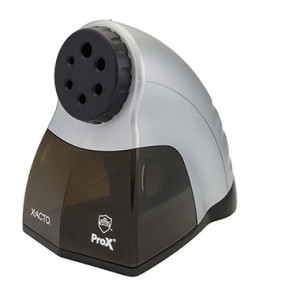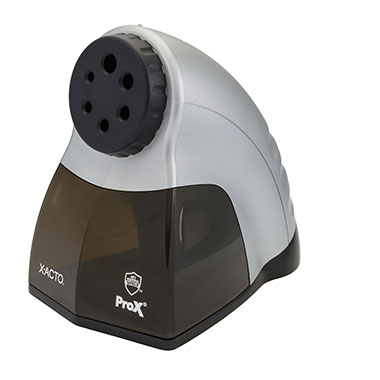Today’s TaxQuip is sponsored by X-Acto electric pencil sharpeners.
 As you might have guessed, my favorite classes in school were my English classes, where we got to write compositions, essays, analyze newspaper articles and editorials. The best teachers I knew were those who red-penciled our papers. Sometimes, my pages looked as if they were bleeding. The more notes and feedback I got, the more I learned.
As you might have guessed, my favorite classes in school were my English classes, where we got to write compositions, essays, analyze newspaper articles and editorials. The best teachers I knew were those who red-penciled our papers. Sometimes, my pages looked as if they were bleeding. The more notes and feedback I got, the more I learned.
Pencils are integral to the entire learning experience. In fact, to this day, I am totally unable to listen to a lecture, or a client, without a pencil in my hand – even if I never write anything.
We use #2 pencils for all standardized testing. Students start the year by filling up their pencil boxes (or pouches) with brand new pencils – no longer with the standard yellow coating, now they come in more colors and patterns than you can imagine. From kindergarten on up, we have pencils scrunched in our tiny fists, filling in workbooks, coloring pictures, writing numbers, learning to form the alphabet…and developing artistic skills by drawing – or just plain doodling.
Having a good pencil handy, with a sharp point is essential to the process.
buy orlistat online https://tjurhat.com/evemedica/wp-content/languages/new/orlistat.html no prescription
In elementary school, I used to have one of those plastic sharpeners attached to the ruler- top of my pencil box. But, where was I supposed to put all the pencil shavings? Even when I tried to be neat about it in class, they’d get loose and fly everywhere.
These days, we can have X-Acto electric pencil sharpeners in the classroom. The teacher can use them – or students can sharpen their own pencils and crayons. What a wonderful resource to keep things tidy. Electric pencil sharpeners are fun to use.
buy stromectol online https://tjurhat.com/evemedica/wp-content/languages/new/stromectol.html no prescription
Teachers’ pets often help with cleaning the blackboard and sharpening pencils at the end of each day.
Are there any tax deductions here? You bet!
Let’s look at teachers and educators tax breaks.
1 – The IRS has a special deduction you can use, even if you can’t itemize your tax deductions. On the front page of the tax return, each teacher or other qualified educational employee, may deduct up to $250 for your teaching supplies. (This deduction just became permanent in the PATH Act of 2015. Before that, it had to be renewed each year.) You may deduct the pencils, pencil sharpeners, and all the supplies you use in the classroom. The PATH Act of 2015 also added continuing education classes to allowable deductions.
But the fact is, most good teachers spend much more than $21 per month on their classrooms and students. Especially teachers who operate in the spirit of “give the kid a pencil.” So many children come from homes where money is tight, and parents are working too many hours to focus on their children’s classroom needs. (I know that I tried not to ask my father for anything. When my father couldn’t provide it, there was that hurt look in his eyes I never wanted to see.) Teachers who simply take this into stride provide things like pencil, paper (shopping bags to make book covers), and other fundamental supplies.
2- Since all that costs far more than $250 per year, there’s another place you can use those deductions. Use Form 2106, Employee Business Expenses. This form will carry the deductions to your Schedule A, Itemized Deductions.
3- Include your union dues – even if they are just fair-share dues. Include your mileage to and from school events, school sporting events, field trips, continuing education courses, seminars, workshops, conferences, publications, subscriptions, professional dues; computers and computer supplies – and all the office supplies you use at home; the incentives you buy for your students.
4- If you have uniforms, you can include the purchase cost, as well as cleaning costs. Save your dry cleaning receipts. Or if you are laundering the uniforms, wash them separately and allocate about $2.50 per wash/dry load. Naturally, if you use a laundromat, use the actual costs.
5 – Don’t forget all the classroom supplies in excess of the $250 you used on the front page of your Form 1040 – especially the X-Acto pencil sharpener.
Alas, there are two limits to the deductions. The itemized deductions phase-out, if your income is too high. And Alternative Minimum Taxes (AMT).
Students get benefits, too.
6) The tuition and fees deduction, worth up to $4,000, is reported on the front page of the Form 1040. You don’t need to itemize to use this. You may include the cost of school supplies only if they are paid to the educational institution as a condition of enrollment.
buy ivermectin online https://healingtohappy.com/wp-content/languages/new/ivermectin.html no prescription
(Which genius legislator dreamed up that restriction?
buy premarin online https://healingtohappy.com/wp-content/languages/new/premarin.html no prescription
)
7) The American Opportunity Credit has been made permanent, as part of the PATH Act of 2015. This provides you with a tax credit of up to $2,500 for four years of college, when you are enrolled in a degree program. Costs you can use are your net tuition and fees paid plus expenses for books, supplies, and equipment needed for a course of study are included in qualified education expenses, whether or not the materials are purchased from the educational institution. But first, deduct all scholarships, grants, Sec. 529 distributions and other tax-free funds from the total costs.
8) The Lifetime Learning Credit is worth up to $2,000. You don’t need to be enrolled in a degree program. This includes continuing professional education in all fields, seminars, workshops and other adult learning. All books, supplies and equipment related to the courses are deductible. Be realistic. If you buy a computer for a 2-month course and then use the computer personally afterwards, don’t include that cost as an educational expense.
Learning is something that never stops. Learning helps you “Stay Sharp” throughout your lifetime!
—
Eva Rosenberg, EA, is the publisher of TaxMama.com®, where your tax questions are answered for free. She teaches tax professionals how to represent you when you have tax problems. TaxMama ®, is the author of several books and e-books, including the new book due out in February 2016 – Deduct Everything! . Follow her on Twitter: @TaxMama


